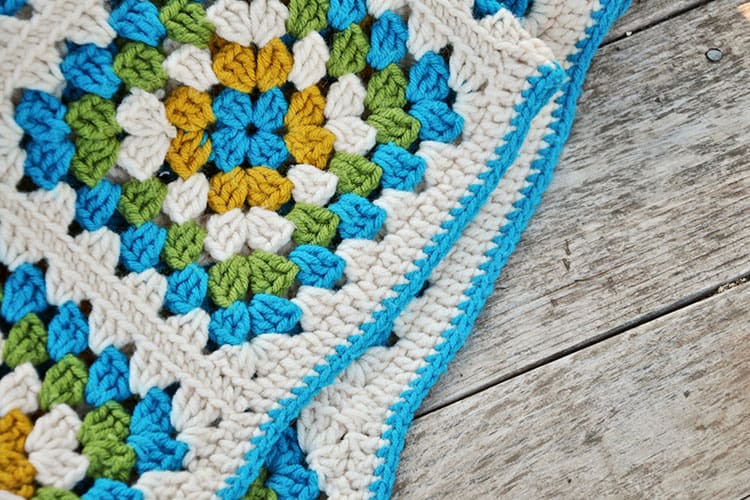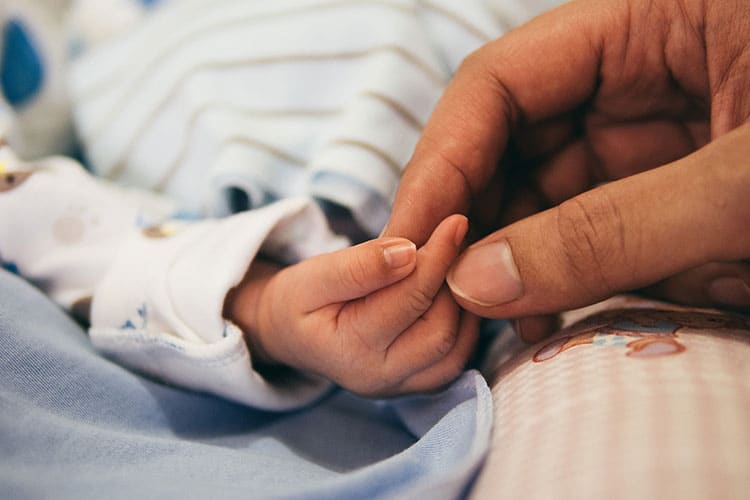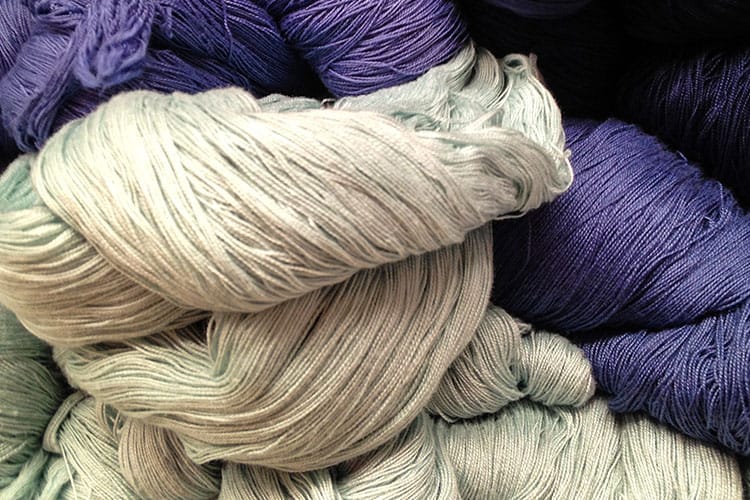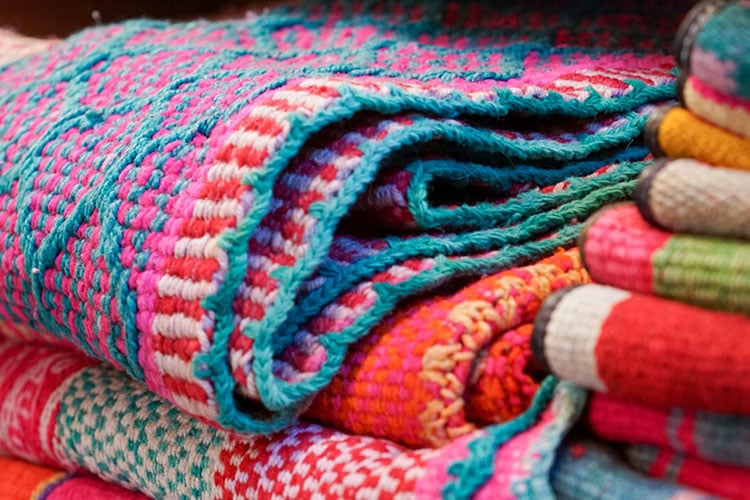Are Crochet Blankets Safe for Babies?
When I was a new mother, I received a crochet blanket as a gift.
Most people are given crochet blankets as gifts because they are handmade, beautiful, and usually come from a beloved friend or family member.
But are crochet blankets safe?
According to the American Academy of Pediatrics, it is recommended that nothing soft be placed in the crib with an infant under 12 months old. Crochet blankets are among these items. They are not safe for babies to sleep with overnight or even while napping in a crib or bassinet.
Safety is a parent’s number one priority as the threat of Sudden Infant Death Syndrome (SIDS) often lurks over us.
With all the stuffed animals, blankets, wraps, and sacks available to us, it can be overwhelming deciding what products to use and which to avoid.
Yes, although marketed for infants, there are still products out there that are recommended against.
What’s Not Safe About Crochet Blankets?

Baby blankets of all types pose a threat to children who aren’t yet one year old.
SIDS is a parent’s worst nightmare and there is no shortage of information out there warning us that this could happen.
SIDS is a condition where babies are laid down for sleep and for unknown reasons, do not wake up again.
The explanations for this phenomenon are ever-changing but blankets in the crib with baby has been renowned as a longstanding contributor.
Crochet blanket safety has been debated by professionals and mommy’s alike and whether to use them resides in a vast gray area.
There are those who believe that because crochet leaves small gaps in the blanket, they are less likely to cause suffocation.
Countering that is the belief that infant’s small fingers and toes can be easily caught in these small holes trapping them in it.
Very young infants have no understanding of nor the ability to keep themselves from a life-threatening situation.
Some argue that they have natural instincts to move away from danger but that just is not true.
If a baby is laid flat on their stomach, some will naturally turn their head to the side while others will stay in a face down position.
If a blanket is laid over a baby, they are powerless to get the blanket off them.
Unless they are part wiggly and part lucky, a parent or caretaker would need to adjust the blanket so that it did not lay in an unsafe position.
Babies are wiggly little buggers and they tend to scoot (sometimes impressive distances) while sleeping.
You may place a blanket over them and even tuck the sides under for added security and yet they will still end up scooching their way underneath of it.
Once under a blanket, they are at risk for smothering and/or suffocation.
How Crochet Blankets Can Be Used Safely

There are times where crochet blankets can be safe for an infant.
They can be laid flat on the floor for adult-supervised tummy time, be wrapped and tucked securely around their torso and legs while sitting in a car seat, swing, or bouncy chair, and can be used as cushion under changing pads.
Daytime use in the manners listed above is considered safe but you should still use caution.
You should never leave an infant unattended while using a blanket.
As a mother of two, I can attest to the fact that babies are somewhat of little Houdini’s.
There will be times where you place them somewhere safe and secure and they will still manage to writhe their way into a strange position or out of it completely.
You will scratch your head and think, “How in the world did you do that?”.
The only way to make sure that they do not end up in an unsafe position is to monitor them closely.
This means not leaving blankets on them to nap if you won’t be in the room, not taking a quick shower, or leaving the room to do household chores.
It only takes a moment for something to go wrong.
What’s the Best Material to Make a Safe and Comfy Crocheted Baby Blanket?

Soft, warm, lightweight, breathable, and durable – these are all qualities you want in a quality infant blanket.
Whether you are making the blanket, giving the blanket, or receive it as a gift, you want to check for these specifics before using it on your baby.
Baby blankets need to be especially strong because they will be washed many times.
They will endure spit up, diaper mishaps, spills, creams, and snacks.
They also need to be lightweight as tiny baby bodies can not bear too much pressure.
Their skin is fresh and sensitive, so scratchy materials such as 100% cotton or wool can be a little rough.
People who crochet baby blankets regularly recommend acrylic yarn or a cotton blend.
You can find cotton/bamboo blends, some linen blends, or cotton acrylic blends that are other good choices for blanket material.
These types of yarn are strong enough to survive several go-rounds in the washing machine yet soft enough to not irritate the skin.
If you receive a blanket as a hand-made gift, don’t be afraid to ask the giver what material was used.
This is important information because it can change how you care for the blanket, is helpful should any allergies pop up, and may determine what you use the blanket for.
Some heavier materials may make a nice playmat or cushion but aren’t ideal for covering baby in a car seat or baby chair.
It is a good idea to pre-wash your infant blanket as sometimes fabric softener can relax the material even more and make it feel softer.
There are special detergent and softener formulas that are made specifically for laundering baby items and they are easily found in most grocery or department stores.’s
The Best Crochet Patterns and Designs for Safe & Cozy Baby Blankets

If you do not crochet you probably think that the pattern doesn’t affect safety or use.
Either way you spin it, it’s still a crocheted blanket.
That isn’t true.
There are many different designs and patterns that can be used – some are lacey, some designed with squares or patches, some tightly woven, and some with an open weave.
When measuring the safety of a crocheted baby blanket there are things you want to avoid:
- Lacey designs
- Large openings or holes
- Beads or weaved in embellishments
- Tassels
- Strands or ribbons
Even though these things can add to the aesthetics of a blanket, they pose significant risks to you baby.
Lacey designs or those with open spaces or holes are particularly a no-no.
Babies can easily get entire body parts, not just fingers and toes, caught in the open spaces.
It is even possible for them to get their head trapped in these openings (see above remark about Houdini’s).
Sometimes beads or small ornaments can be weaved into a blanket as decoration or they may be family heirlooms.
I received a blanket with a belt buckle passed down from a great-grandfather weaved into it.
While it was a very lovely gift and full of sentiment, it was a definite hazard to my baby.
These items are hard and uncomfortable to lay on.
They can also become loose and fall out or may even be chewed on by baby.
This presents a risk that your baby could choke.
Tassels and ribbon or strands also throw up a red flag.
Babies will suck on anything they can get their hands on and anything loose could potentially break off and end up in your baby’s mouth.
Safe blankets should be weaved in a simple, structured pattern with a smooth, tightly spun yard, with secured edging.
Don’t worry! If you receive a crochet blanket that does not meet the safety requirements needed for an infant, keep in mind that they won’t be an infant forever.
Once your baby is a few years old, the dangers of using blankets drops significantly.
Gifted blankets can always be placed aside until the child is at an appropriate age or can be used as decoration pieces until then.
Related Questions

What types of items are safe in a crib?
It is recommended that nothing be placed in the crib with an infant.
This includes bumper padding, stuffed animals, toys of any kind, blankets, or pillows.
Your baby will squirm and inch it’s way around the entire crib space so even having these items in a corner or hanging on the side of a crib is cautioned against.
Babies should be placed in the center of an empty crib, on their backs, in secure sleepwear.
You can always speak with your pediatrician if you have any concerns about crib safety.
At what age can children safely sleep with a blanket?
Children should not sleep with a blanket or any other soft bedding until they are at least one year old.
Appropriate sleepwear does an excellent job of keeping an infant warm and comfortable until then.
There are numerous sleep sacks, wearable blankets, jumpers, and swaddle blankets designed for safe sleeping.


Thank you for this advice I thought a lacy blanket looks lovely but on reading your tips I will be sure to pick a stitch with no holes in it
Again thank you
Best regards
Carmel Trehy